th - 1987 - 51st ENC Conference
th - 1987 - 51st ENC Conference
th - 1987 - 51st ENC Conference
You also want an ePaper? Increase the reach of your titles
YUMPU automatically turns print PDFs into web optimized ePapers that Google loves.
MF23 - POSTERS<br />
NMR INVESTIGATIONS OF ATOMIC MICROSTRUCTURE<br />
IN AMORPHOUS SEMICONDUCTORS<br />
Q<br />
Karen K. Gleason , Mark A. Petrich, and Jeffrey A. Reimer,<br />
.Department of Chemical Engineering, University of California,<br />
Berkeley, CA 94720-9989.<br />
The microstructure of amorphous semiconductors has important<br />
implications for <strong>th</strong>eir electronic properties. Nuclear magnetic<br />
resonance (NMR) can examine <strong>th</strong>e microstructure of <strong>th</strong>ese materials<br />
on an atomic scale. Previous NMR results have indicated <strong>th</strong>at <strong>th</strong>e<br />
hydrogen in <strong>th</strong>ese materials exists bo<strong>th</strong> as isolated hydrogen atoms<br />
and as clusters of hydrogen. Using Multiple Quantum NMR, a<br />
technique which is able to "count" <strong>th</strong>e number of hydrogen atoms in a<br />
cluster, we have studied <strong>th</strong>e effects of deposition temperature,<br />
dopant atoms, and annealing on <strong>th</strong>e clustering of hydrogen in<br />
amorphous silicon. Our results indicate <strong>th</strong>at electronic device<br />
quality amorphous silicon films contain small clusters of<br />
approximately six hydrogen atoms, while nondevice quality films<br />
contain larger hydrogen atom clusters. We have also extended <strong>th</strong>e<br />
multiple quantum NMR technique to study a series of amorphous<br />
silicon carbide alloys, systematically varied in carbon content. We<br />
have found <strong>th</strong>at small amounts of carbon decrease <strong>th</strong>e total hydrogen<br />
content of <strong>th</strong>e alloy, but increase hydrogen clustering. Carbon-13<br />
and silicon-29 magic-angle spinning NMR spectra, taken wi<strong>th</strong> and<br />
wi<strong>th</strong>out proton decoupling, allow us to probe local bonding<br />
configurations. These studies have shown <strong>th</strong>at bo<strong>th</strong> sp 2 and sp 3<br />
carbon bonding environments are important in <strong>th</strong>ese materials. It is<br />
especially interesting <strong>th</strong>at nearly all <strong>th</strong>e hydrogenated carbon are<br />
in <strong>th</strong>e sp 3 bonding configuration.<br />
By comparing our NMR results wi<strong>th</strong> data from o<strong>th</strong>er analytical<br />
techniques such as infrared and optical absorption spectroscopy,<br />
Ru<strong>th</strong>erford backscattering, and conductivity measurements, we hope<br />
to elucidate <strong>th</strong>e relationships between deposition chemistry, atomic<br />
microstructure, and optoelectronic properties of <strong>th</strong>is<br />
technologically important class of materials.<br />
Supported by NSF grant DMR-8304163.













